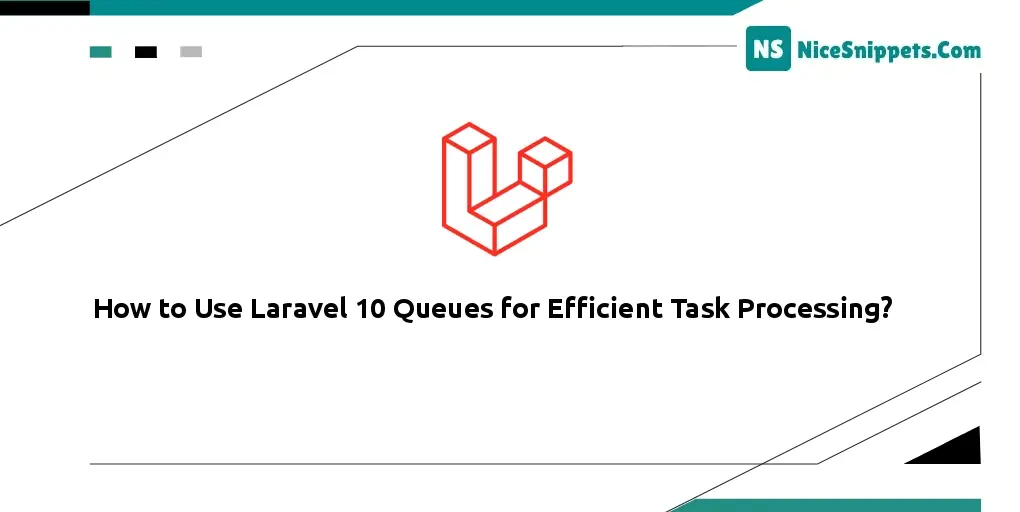15-Dec-2023
.
Admin

Hello Dev,
Today our leading topic is how to run queue jobs in Laravel 10. I would like to show you how to implement a queue in Laravel 10. Here you will learn how to use queueing in Laravel 10. you will learn how to use Laravel 10 queues for efficient task processing.
Laravel is a widely-used PHP web application framework that offers developers a range of features and tools, including an efficient job processing system called queues. Queues enable you to defer time-consuming tasks, like sending emails or generating reports, for background processing. This capability frees up your application to handle other requests seamlessly.
Step 1: Configure your Queue Driver
Laravel supports various queue drivers, such as Redis, Amazon SQS, and Beanstalkd. Choosing the right driver for your application depends on its specific requirements and environment.
To configure the queue driver, navigate to the .env file in your Laravel application's root directory and set the QUEUE_CONNECTION variable to the desired driver.
QUEUE_CONNECTION=redis
Step 2: Create a Job Class
Next, create a job class representing the task you intend to process. Ensure that your job class extends the Illuminate\Contracts\Queue\ShouldQueue interface. This interface signifies that the job can be added to the queue.
For example, let’s create a job that sends an email to a user.
php artisan make:job SendEmailJob
This action generates a new job class in the app/Jobs directory. You can specify the logic for the job within the handle method.
<?php
namespace App\Jobs;
use Illuminate\Bus\Queueable;
use Illuminate\Contracts\Queue\ShouldQueue;
use Illuminate\Foundation\Bus\Dispatchable;
use Illuminate\Queue\InteractsWithQueue;
use Illuminate\Queue\SerializesModels;
use Illuminate\Support\Facades\Mail;
class SendEmailJob implements ShouldQueue
{
use Dispatchable, InteractsWithQueue, Queueable, SerializesModels;
protected $user;
/**
* Create a new job instance.
*/
public function __construct($user)
{
$this->user = $user;
}
/**
* Execute the job.
*/
public function handle()
{
Mail::to($this->user->email)->send(new \App\Mail\WelcomeEmail($this->user));
}
}
Step 3: Dispatch the Job to the Queue
After defining your job class, dispatch it to the queue using the dispatch method. For instance, let's dispatch the SendEmailJob with the user object as its parameter.
$user = User::find(1);
dispatch(new SendEmailJob($user));
Alternatively, you can utilize the dispatchNow method to execute the job immediately without adding it to the queue.
dispatch_now(new SendEmailJob($user));
Step 4: Process the Queue
To process the queued jobs, initiate a queue worker. Laravel offers various queue workers, and one common option is the php artisan queue:work command. This command activates a worker that consistently monitors the queue, processing jobs as they become available.
php artisan queue:work
You can also specify the queue name and the number of worker threads by using the --queue and --tries options, respectively.
php artisan queue:work --queue=emails --tries=3
This will execute a worker dedicated to processing jobs from the 'emails' queue, with the ability to retry failed jobs up to three times.
Step 5: Monitor the Queue
To monitor the status of your queued jobs, consider using the Laravel Horizon package. This package offers a dashboard that provides information about queue workers, jobs, and failed jobs.
To install and configure Laravel Horizon, run the following command.
composer require laravel/horizon
In conclusion, Laravel queues provide a powerful way to manage time-consuming tasks in the background, allowing your application to handle other requests efficiently. By following the steps outlined in this article, you can easily set up and use Laravel queues in your application. With the ability to monitor and manage the queue using Laravel Horizon, you can ensure that your application is running smoothly and efficiently.
I hope it can help you...
#Laravel 10